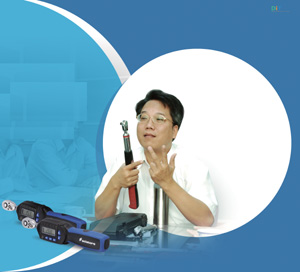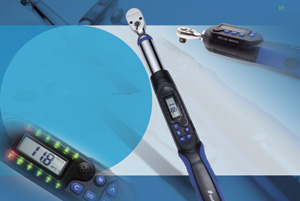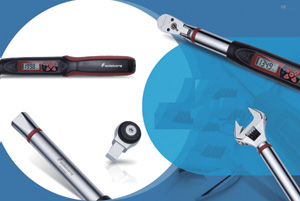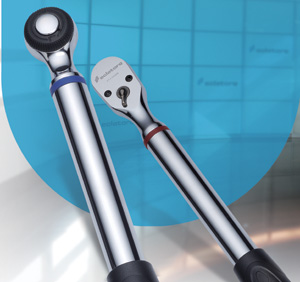Eclatorq Technology Co., Ltd.
Calibration-grade hand tools, digital gauges
2009/03/24 | By Ken Liu | ECLATORQ TECHNOLOGY CO., LTD.There are already many global suppliers of digital tools for engineers to calibrate machines, but only one who can turn out digital tools specifically for professional repairs and maintenance work in different fields Eclatorq Technology Co.
Usually, established tools makers like Snapon of the United States, KTC of Japan, and Gedore of Europe make tools equipped with digital gauges specifically for calibration purposes although sometimes highly-paid professional workers buy such tools for repairing and maintenance work, with these calibration tools used to gauge tension force.

However, these tools are unpopular due to high retail prices, caused by high production costs as a result of their special specifications that hinder mass production. Usually being wrenches, these tools are bigger than counterparts for the bulky digital meters embedded in them. “In addition, the digital meters are still rife with problems,” comments Ming-hua Li, Eclatorq's general manager.
Li was formally a project manager at the Taichung branch of Mechanical Industry Research Laboratories (MIRL) of the government-backed Industrial Technology Research Institute (ITRI). He was responsible for the government-funded NT$50 million (US$1.5 million at US$1:NT$33) digital hand-tool project when he was in that position.

The company's digital gauge is only about the size of a thumb, making it easily adaptable in standard-sized tools. “For this reason, we can mass produce our digital tools and bring down costs,” Li says.
“Put aside price advantage, our gauge has impact-resistance design and shows highly reliable data,” Li stresses. To prove the gauge is shock resistant, he intentionally dropped a digital wrench from a height of around 180 centimeters. He then used the tool in front of visitors to show it still worked.
Since most tools are often used under harsh conditions, Eclatorq has made its digital gauges resistant to extreme temperatures, where they work from 20 Celsius below freezing to 70 Celsius degrees above zero.

Plus the digital gauges also resist acid corrosion, water, vibration, oil, and electromagnetic interference in addition to being impact and temperature resistant.
So far, his company has built the gauge into wrenches and car pullers, and is planning to integrate it in screwdrivers. Whatever tool it is in, the gauge always displays real-time result thanks to the built-in central processing unit.
The core of Eclatorq's digital technology is a micro electromechanical system (MEMS) that incorporates signal-sensing, dada-processing and data-display capabilities. Its meter allows users to set torque, store previous torque data, and convert measurement unit between metric and imperial systems.
In terms of data storage capability, the company's a category of tools are designed to save up to 250 batches of data while its B category can save one-fifth as much. A-category tools are specifically designed for repairing aircrafts whereas B-category tools are for repairing vehicles like cars and motorcycles.

The company attaches more valuable components to A-category tools, with the most notable being a CD carrying a drive program, a calibration program and a cable for connecting the tools to personal computer for on-line calibration. The two software pieces are developed by Eclatorq in-house and compatible with only Windows XP and Windows 2000.
The standard attachments included in both categories are a warranty, a calibration report, desiccants, two AA batteries, and a description. Also available are one-year free online maintenance and repair package, and rechargeable batteries are compatible.
Li was in charge of the digital technology project from day one at MIRL. He recalls that the technology was designated for development around 2001 by the government, which was urged by local hand-tool manufacturers to help the industry boost product value in face of mainland Chinese rivals' underselling competition.
“We targeted this technology because no other country had ever developed a miniature electronic meter like ours for hand tools,” Li recalls. “And digital meters have a practical side, mainly because they are more accurate than mechanical devices when used with some tools.”
Li and his team's core idea behind the digital technology was integrating the meter into tools without structural changes so that digital-equipped tools may be mass produced at fairly competitive costs.
When the technology was made a reality in 2004, he was asked to commercialize the technology by helping set up the NT$95 million (US$2.8 million) Eclatorq.
The company began at an incubator center in the Taichung branch of MIRL and moved to the Taichung Export Processing Zone last year. It first debuted the tool in 2005 at a hardware trade show in Las Vegas and attracted to its booth E.C. Barton, ACE, Home Depot, Assured Imports, Amazon, Orchard Supply Hardware, K-Mart, and Sears.
However, buyers see its tools as mere calibration tools due to the integrated measuring gauge, compromising Eclatorq's advantage since the segment is already occupied by big names. “So, we decided to reposition our tools and have been targeting professional maintenance and repair people in various industries,” Li says.
The digital-equipped tools have an edge on professional-caliber repair and maintenance tools due to the company's considerably lower prices-about 70% of that of competitors. The tools are now available in 200 specifications of wrenches for mechanics in automotive, motorbike and bicycle shops. The company plans to integrate the meter in garden tools and power tools over the next few years.
With nearly US$1 million worth of trial orders from European, American, and Japanese buyers flooding in April alone, Li is confidently predicting sales of NT$80 million (US$2.4 million) for this year and NT$150 million (US$4.5 million) for 2008. He estimates global consumption of digital tools to be around US$909 million annually, with the main suppliers being Snapon, KTC, and Gedore.
At the 21,600-square-foot factory in the export processing zone, the company will double monthly output to 4,000 units by adding another production line. “We're ready for volume production right now. Once our customers accept our pilot products, we'll go ahead full throttle.”
The general manager believes that high-value-added products like digital tools will help Taiwanese producers regain some of the market share they have lost to mainland Chinese suppliers. China replaced Taiwan as the world's No. 1 hand-tool exporter in 2003, exporting US$1.38 billion worth of the products, compared to Taiwan's US$1.29 billion.
Li believes that digital tools will energize the island's hand-tool industry, and predicts that digitization will add NT$35 million (US$1.06 billion) to Taiwan's hand-tool revenues in 2009, boosting the figure past the NT$100 billion (US$3 billion) mark. Li hopes that these tools will also help boost Taiwan's share of the global hand-tool market to 40% from the current 20%.
“No one in the world can compete with us in digital-tool manufacturing. We offer competitive pricing, flexible production and diversified products,” Li concludes.




